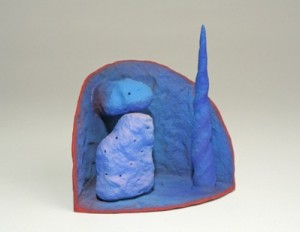
Ron Nagle: Ominous Charms
When you grok the size of Ron Nagles ceramic sculpture on view at James Kelly Contemporary in Santa Fe to 9/25 — often theyre only about 4 inches tall, as slim as 2 â… deep, and maxing out at about 8 inches wide — you come face to face with why scale and size are not, never in (good) art, equal.

Ron Nagle, "Teens of August", 2009
For Nagles packed little ceramics achieve in scale what their size would appear to abjure, were you to take their measurements (as I have). That is, these are very powerfully scaled very small objects. They run with a big energy handily contained in their sly and often wittily elusive surface-depth relationships. Their matte polychrome glazes, many many layers thin, have the delicate appearance of the finish on French candied almonds (see Watusi Jenkins, Mirdir Inc), as if they might shake off a residue on wax paper of confectionary ephemera.
Yet, as you engage more deeply with how they appear, these skinny little things, with sometimes a plump appendage, a handle maybe slim also bulbous, or a mounded little hillock near a glossy demi-tongue that partly conceals an aperture, it is description the surface makes perplexing. You wind up having to hand narrative over to the imaginal, the cup over to the idea of the mad hatters tea party where no beverage is to be served.
Sometimes, because of their appearance (or our tendency to ascribe narrative), the portals in Nagles ceramics that could inscribe a relationship between brackets (a front-a back) and an architecture of free-standing clay, instead resemble a surrealist dream panel, as if — if you removed the shadow of the column and the unicyclist from a Giorgio de Chirico landscape — the feel of the absent landscape, in miniature, would be like this. A where you could not say you had seen until seeing a Ron Nagle.
Nagle taught ceramics for 32 years at Mills College (he retired this year), and San Francisco — where he was born (in 39) and studied at San Francisco State College —

Ron Nagle, "Minametti", 2008
has proven to dominate his biography as critic after critic inevitably compare him to Ken Price, about whom he once said: “I did take my cue from Price … in attitude.”
Yet attitude sympathy apart, their work is really so different. Prices work is to my eye bio- and anthropomorphic; Nagles is, to my way of seeing, never. Prices ceramics are painted, Nagles are glazed. Nagle was the studio assistant of Peter Voulkos in Berkeley in the 70s, after Voulkos, seminal along with Kenny Price and Billy Al Bengston, put footsteps in the sand to parallel the rise of new clay sculpture from California, where the regional relationship exploded form and reputation. Reverenced among each other. Paying homage to those encounters, Dave Hickey when he curated SITE Santa Fes Beau Monde biennial put Ken Price sculpture on pedestals and hung four walls with Ellsworth Kelly paintings. Exhorting us to see “beauty.” Beauty as a promise of democracy, democracy as a conversation that converts prior obligation into future zealous anarchist.
In Nagle, interestingly, what beauty you would call by the name, apart from the lickable colors (a beautiful day, an ignorance a sunset), is more like desire turned strange, diagrams of a concept of a house to live in which still despite its intriguing walls turns you back. (Break-able.)
Nagle cites Giorgio Morandi as an influence on him and wow, I found that interesting having just seen a Morandi at the New York Armory Show in March this year. When you construe, out of the planes of a Morandi still life, where the outlines of bottles distinguish from the table line, that helps you lift an edge of skin to maybe get (barely) under Nagles narrow ceramic so sturdy so fragile so weighty yet light. If table is line and edge is shape form is a very narrow threshold indeed. A Rose Grows in Coma got me started thinking wordplay. Langston Hughess Mother to Son poem, well, son, Ill tell you:
Life for me aint been no crystal stair.
What if you called it a crystal stare, the rose in a tower encountering the well of dreams.
